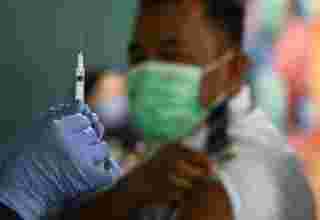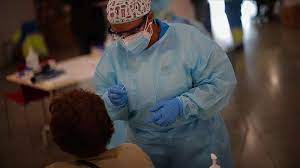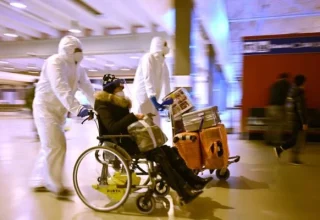ISLAMABAD, OCT 03 (ABC): Strokes can drastically change the mind and body. Symptoms may differ among individuals, but many experiences are common.
Strokes occur when a clot or burst artery prevents blood from getting to the brain. When brain cells do not receive enough blood, they can be damaged or die.
Different parts of the brain control different bodily functions, so a stroke can affect almost any part of the body.
While it is difficult to predict a stroke, a person can take steps to lower their risk. Read on, to learn how strokes feel and how to tell if someone is having one.
We have also spoken with Tracy Lomagno, who survived a stroke earlier this year. She shares her experience, and details the physical and emotional impact that it has had on her.
What does a stroke feel like?
The list below includes classic signs of stroke. It is common to only experience some of the symptoms.
For example, a person experiencing numbness and difficulty balancing due to a stroke may not also have cognitive problems. This may put them off going to the hospital.
If someone experiences any of the following symptoms, they should seek medical aid as soon as possible:
- problems talking or understanding others
- numbness or drooping on one side of the face
- numbness or weakness on one side of the body
- trouble walking or balancing
- vision problems
- a sharp or severe headache
- dizziness
- trouble swallowing
Of these symptoms, only the headache is painful. Many people who have a stroke do not feel any pain.
If a person is unsure whether something is wrong, they may ignore the other symptoms. However, in cases of a stroke, fast action is essential. Be aware of all the symptoms, and be prepared to call an ambulance if they appear.
Anyone who may be having a stroke should not drive. Symptoms may rapidly become worse, and they could harm themselves or others in an accident.
In the following video, a scientist talks about what it felt like to have a stroke. She recognized the signs and witnessed the gradual disappearance of her speech, memory, and ability to move:
What to do
The Act FAST campaignTrusted Source aims to educate people so that they can recognize a stroke as soon as possible. This is because the longer a stroke is untreated, the more damage it can do. FAST is an acronym that stands for:
- Facial drooping
- Arm weakness
- Speech difficulties
- Time to call emergency services
If a person cannot lift both arms, smile with both sides of the mouth, or say a full sentence, it is essential to seek emergency care. Any of these symptoms can signal a stroke.
What are the effects of a stroke?
The effects of a stroke vary, depending on the affected area of the brain.
Another factor is how long it took to receive treatment. Any delay allows more brain cells to die or be damaged.
Some people only experience minor effects after a stroke, such as fatigue or difficulty with coordination. Others may need to relearn basic functions, such as walking and swallowing, and they will need ongoing support.
According to the Centers for Disease Control and Prevention (CDC), strokes are responsible for one in 20 deathsTrusted Source in the United States.
Tracy Lomagno had a stroke in the cerebellum area of the brain in February 2018. She kindly spoke to us about her experience with each of the symptoms below:
Vision
Approximately one-third of people who experience a stroke have problems seeing afterward. These can range from some blurring in one eye to total blindness.
Some people, such as Tracy, will also notice that their sight is affected at the time of the stroke. She describes her experience below:
Imagine being on a teacup ride at an amusement park, spinning 1,000,000 miles an hour, while not being able to focus. That’s how I felt if I opened my eyes. If I moved an eyelash or attempted to let the tiniest amount of light in, I would catch a glimpse of the spinning which would cause me to vomit violently.
While some visual function can improve after a stroke, a complete recovery is uncommon.
The following visual difficulties can also be caused by a stroke:
- impaired eye mobility
- partial vision loss
- dry eyes
- unsteady, jittery eye movement
Less common visual difficulties include:
- Agnosia, which refers to difficulty recognizing familiar faces or objects.
- Visual neglect, which involves being unaware of things on the side of the body affected by the stroke.
Physical effects
Share on PinterestDifficulty swallowing is a common symptom after a stroke.
Following a stroke, some people experience:
- difficulty swallowing, which is known as dysphagia
- an inability to lift the front of the foot, which is called foot drop
- incontinence
- pain
- fatigue
- paralysis
- seizures
- problems sleeping
- poor muscle control
- muscle spasms
An individual may have a variety of these symptoms or only one. They can range in severity and may get better over time.
It is also very common to experience a loss of control over bodily functions during the stoke itself, as Tracy explains:
All of a sudden I started to feel my legs and arms tingle, they became numb and very limp. I lost control of my bladder a small amount and the sweating was so intense that I was soaked. By the time I got from my room to the ambulance I could not speak at all. My face was tingling, my body was limp, and I was sweating profusely.
Emotional impact
A stroke can leave a person feeling shaken, confused, and scared. Strokes are life-changing events and may require a person to relearn basic functions or activities.
The entire time I was thinking about my son, and hoping I would make it out of this alive.
Everyone’s experience is different, but it is usually helpful to speak about a stroke and its emotional impact with friends, family, a therapist, or a support group.
A person who has had a stroke may experience:
- depression
- feelings of vulnerability
- a loss of identity
- anxiety
- feelings of being a burden
- frustration
It is crucial to speak with a professional if these feelings start to become overwhelming. A therapist can help a person to deal with the emotional impact of a stroke and make changes to reduce stress.
Tracy highlights some of the other services that are available below:
Please be comfortable with your doctors. It’s more important than anyone can imagine. Even though I felt more alone than I ever have in my life, there are ways to help with the emotional trauma. I requested therapy dogs at the rehabilitation center every day, and have now registered my greyhound Silka as a service dog to assist me at home. I have also formed a daily routine with my husband and feel more comfortable as a result of this.
Types of stroke
There are three types of stroke.
- Ischemic strokes, which are caused by clots that block blood flow
- Hemorrhagic strokes, which occur when a blood vessel bursts
- Ministrokes, or transient ischemic attacks, which are caused by temporary clots
What does a ministroke feel like?
Signs and symptoms of ministrokes are the same as those of other strokes, but they may pass more quickly.
A ministroke typically lasts between a few minutes and a few hours. Symptoms may pass so quickly that a person barely notices them. For example, a person may have difficulty speaking or moving for a few minutes before the function returns.
Anyone who suspects that they have had a ministroke should seek emergency care. They serve as a serious warning that a full stroke may occur.
What causes strokes?
Ischemic strokes are caused by clots in blood vessels that block the flow of blood to the brain. Hemorrhagic strokes occur when a weakened blood vessel in the brain bursts.
It is not possible to foresee a stroke, but certain factors increase a person’s risk.
Unavoidable risk factors include:
- Age. As arteries age, they harden and narrow, making it easier for them to become blocked.
- Sex. Younger men are more at risk than younger women. However, after menopause, women are more likely than men to die of stroke.
- Family history. If a close relative has had a stroke, a person is more likely to have one.
- Personal history. If a person has already had a stroke, it increases their risk of another.
Avoiding the following can reduce the risk of having a stroke:
- smoking
- obesity
- alcohol consumption
- low levels of exercise
- stress
- nonsteroidal anti-inflammatory drugs, including ibuprofen and naproxen
- hormonal birth control pills
A person may be more vulnerable to a stroke if they have any of the following conditions:
- depression
- high cholesterol
- high blood pressure
- sickle cell diseaseTrusted Source
- vasculitisTrusted Source, which involves inflammation of the blood vessels
- diabetes
Knowledge is power. Get our free daily newsletter.
Dig deeper into the health topics you care about most. Subscribe to our facts-first newsletter today.
Recovery
Every stroke has different effects, and the extent of damage varies widely from person to person. Stroke teams will assess the impact and monitor a person’s progress in the hospital and at home.
Recovery may be a long process, but many benefit from occupational therapy and other forms of support aimed at restoring a person’s independence.


























